Determination of Temporary Hubs Locations Along a River in Case of Flood
Abstract
1. Introduction
1.1. Background
- -
- Shelter for the persons evacuated from the flooded area;
- -
- Direction and coordination of the fieldwork of the operative task forces;
- -
- Communication services;
- -
- Infrastructure for the public relations activities (e.g., press conferences);
- -
- Storage of inventory for the crisis response and recovery;
- -
- First-aid center for injured persons in the process of operations;
- -
- Center for public administration and jurisdiction.
1.2. Literature Review
1.2.1. Optimization Modeling in Humanitarian Logistics and Disaster Management Related to Hubs
1.2.2. Coverage Location Optimization Models
2. Methodology
2.1. Research Design
2.2. Methods Description
2.3. Mathematical Models Approach and Concept Description
3. Results and Discussion
3.1. Development of a Model for Optimal Distribution of Hubs for No-Dam Case
- In the case of a flood, passing the river with a large amount of relief items can be dangerous. Therefore, the methods and models discussed below concern the defense of one side of the river. However, if aerial transportation is possible with drones having a large transportation capacity, then the hubs can be on both sides of the river. A single system can also serve both sides in that case.
- The part of the river where the defense takes place can be considered as a linear segment. It is Here the length of the segment is .
- Positions of the potential locations are determined by two data. The first one is how far it is from the starting point 0 of the segment. The second one is the height.
- All places within the segment must have a hub within an a priori defined distance .
- A preliminary investigation selects a finite number of potential locations. Each one is a possible place for a temporary hub.
- The number of the selected potential locations is fixed.
3.2. Mathematical Model for the Case of Existing Dam
4. Summary and Policy Implications
Author Contributions
Funding
Data Availability Statement
Conflicts of Interest
Appendix A
| Location | Distance | Height | Location | Distance | Height |
|---|---|---|---|---|---|
| km | m | km | m | ||
| 1 | 3.00 | 11.57 | 26 | 106.74 | 12.87 |
| 2 | 5.78 | 11.19 | 27 | 108.90 | 14.00 |
| 3 | 11.53 | 15.44 | 28 | 114.56 | 15.36 |
| 4 | 15.08 | 11.78 | 29 | 118.72 | 11.13 |
| 5 | 19.67 | 13.66 | 30 | 122.69 | 13.18 |
| 6 | 22.97 | 12.24 | 31 | 128.16 | 11.17 |
| 7 | 29.27 | 12.63 | 32 | 131.50 | 13.28 |
| 8 | 31.21 | 12.45 | 33 | 132.59 | 13.69 |
| 9 | 33.90 | 15.94 | 34 | 138.75 | 14.63 |
| 10 | 39.11 | 11.76 | 35 | 140.70 | 12.33 |
| 11 | 40.73 | 11.39 | 36 | 144.75 | 12.74 |
| 12 | 45.12 | 15.62 | 37 | 148.75 | 15.65 |
| 13 | 47.62 | 13.14 | 38 | 149.85 | 15.62 |
| 14 | 52.89 | 11.55 | 39 | 156.49 | 13.13 |
| 15 | 59.87 | 12.88 | 40 | 159.08 | 12.18 |
| 16 | 63.84 | 11.27 | 41 | 163.23 | 12.07 |
| 17 | 66.23 | 15.27 | 42 | 167.88 | 12.77 |
| 18 | 72.69 | 15.93 | 43 | 171.42 | 14.24 |
| 19 | 78.92 | 13.93 | 44 | 172.89 | 15.99 |
| 20 | 80.13 | 14.02 | 45 | 175.79 | 11.07 |
| 21 | 81.33 | 14.96 | 46 | 177.16 | 14.25 |
| 22 | 87.62 | 12.10 | 47 | 178.46 | 15.85 |
| 23 | 94.07 | 15.31 | 48 | 180.37 | 12.69 |
| 24 | 100.80 | 11.18 | 49 | 182.59 | 13.17 |
| 25 | 102.71 | 12.96 | 50 | 189.11 | 14.33 |
References
- Doocy, S.; Daniels, A.; Murray, S.; Kirsch, T.D. The human impact of floods: A historical review of events 1980–2009 and systematic literature review. PLoS Curr. 2013, 5. [Google Scholar] [CrossRef] [PubMed]
- Centre for Research on the Epidemiology of Disasters (CRED). 2024. Available online: https://www.emdat.be/ (accessed on 1 January 2025).
- Kundzewicz, Z. Is the frequency and intensity of flooding changing in Europe? In Extreme Weather Events and Public Health Responses; Springer: Berlin/Heidelberg, Germany, 2005; pp. 25–32. [Google Scholar]
- Breinl, K.; Lun, D.; Müller-Thomy, H.; Blöschl, G. Understanding the relationship between rainfall and flood probabilities through combined intensity-duration-frequency analysis. J. Hydrol. 2021, 602, 126759. [Google Scholar] [CrossRef]
- The Organization of Economic Cooperation and Development (OECD). 2019. Available online: https://www.oecd.org/ (accessed on 1 January 2015).
- De Leeuw, S.; Vis, I.F.; Jonkman, S.N. Exploring logistics aspects of flood emergency measures. J. Contingencies Crisis Manag. 2012, 20, 166–179. [Google Scholar] [CrossRef]
- Özdamar, L.; Ertem, M.A. Models, Solutions and enabling technologies in humanitarian logistics. Eur. J. Oper. Res. 2015, 244, 55–65. [Google Scholar] [CrossRef]
- Boonmee, C.; Arimura, A.; Asada, T. Facility location optimization model for emergency humanitarian logistics. Int. J. Disaster Risk Reduct. 2017, 24, 485–498. [Google Scholar] [CrossRef]
- Caunhye, A.M.; Nie, X.; Pokharel, S. Optimization models in emergency logistics: A literature review. Socio-Econ. Plan. Sci. 2012, 46, 4–13. [Google Scholar] [CrossRef]
- Rivera-Royero, D.; Galindo, G.; Yie-Pinedo, R. A dynamic model for disaster response considering prioritized demand points. Socio-Econ. Plan. Sci. 2016, 55, 59–75. [Google Scholar] [CrossRef]
- Maharjan, R.; Hanaoka, S. A credibility-based multi-objective temporary logistics hub location-allocation model for relief supply and distribution under uncertainty. Int. J. Environ. Res. 2020, 70, 100727. [Google Scholar] [CrossRef]
- Tavana, M.; Abtahi, A.-R.; Di Caprio, D.; Hashemi, R.; Yousefi-Zenouz, R. An integrated location-inventory-routing humanitarian supply chain network with pre- and post-disaster management considerations. Socio-Econ. Plan. Sci. 2018, 64, 21–37. [Google Scholar] [CrossRef]
- Garrido, R.A.; Lamas, P.; Pino, F.J. A stochastic programming approach for floods emergency logistics. Transp. Res. Part E Logist. Transp. Rev. 2015, 75, 18–31. [Google Scholar] [CrossRef]
- Mollah, A.K.; Sadhukhan, S.; Das, P.; Anis, M.Z. A cost optimization model and solutions for shelter allocation and relief distribution in flood scenario. Int. J. Disaster Risk Reduct. 2018, 31, 1187–1198. [Google Scholar] [CrossRef]
- Maharjan, R.; Shrestha, Y.; Rakhal, B.; Suman, S.; Hulst, J.; Hanaoka, S.; Management, S.C. Mobile logistics hubs prepositioning for emergency preparedness and response in Nepal. Int. J. Prod. Econ. 2020, 10, 555–572. [Google Scholar] [CrossRef]
- Drakulić, D.; Takači, A.; Marić, M. New model of maximal covering location problem with fuzzy conditions. Comput. Inform. 2016, 35, 635–652. [Google Scholar]
- Jia, H.; Ordóñez, F.; Dessouky, M. A modeling framework for facility location of medical services for large-scale emergencies. IIE Trans. 2007, 39, 41–55. [Google Scholar] [CrossRef]
- Hashim, N.I.M.; Shariff, S.S.R.; Deni, S.M. Allocation of Relief Centre for Flood Victims Using Location Set Covering Problem (LSCP). J. Phys. Conf. Ser. 2021, 2084, 012016. [Google Scholar] [CrossRef]
- Hashemi, A.; Gholami, H.; Venkatadri, U.; Sattarpanah Karganroudi, S.; Khouri, S.; Wojciechowski, A.; Streimikiene, D. A New Direct Coefficient-Based Heuristic Algorithm for Set Covering Problems. Int. J. Fuzzy Syst. 2022, 24, 1131–1147. [Google Scholar] [CrossRef]
- Alizadeh, R.; Nishi, T. Hybrid Covering Location Problem: Set Covering and Modular Maximal Covering Location Problem. In Proceedings of the 2019 IEEE International Conference on Industrial Engineering and Engineering Management (IEEM), Macao, China, 15–18 December 2019. [Google Scholar]
- Blanquero, R.; Carrizosa, E.; Gazdag-Tóth, B. Maximal covering location problems on networks with regional demand. Omega 2016, 64, 77–85. [Google Scholar] [CrossRef]
- Park, Y.; Nielsen, P.; Moon, I. Unmanned aerial vehicle set covering problem considering fixed-radius coverage constraint. Comput. Oper. Res. 2020, 119, 104936. [Google Scholar] [CrossRef]
- Habib, A.; Szantai, T. New bounds on the reliability on the consecutive k-out-of-r-from-n: F system. Reliab. Eng. Syst. Saf. 2000, 68, 97–104. [Google Scholar] [CrossRef]
- Dimitrova, Z.I.; Vitanov, N.K. Analysis of extreme water levels of Indus, Ganges, and Brahmaputra rivers. Comptes Rendus L’académie Bulg. Sci. 2020, 73, 1729–1735. [Google Scholar]
- Chowdhury, J.U.; Stedinger, J.R.; Lu, L.H. Goodness-of-fit tests for regional generalized extreme value flood distributions. Water Resour. Res. 1991, 27, 1765–1776. [Google Scholar] [CrossRef]
- Berz, G. Flood disasters: Lessons from the past—Worries for the future. Proc. Inst. Civ. Eng.-Water Marit. Eng. 2000, 142, 3–8. [Google Scholar] [CrossRef]
- Kron, W. Flood disasters—A global perspective. Water Policy 2015, 17, 6–24. [Google Scholar] [CrossRef]
- Church, R.; Revelle, C. The maximal covering location problem. Pap. Reg. Sci. Assoc. 1974, 32, 101–118. [Google Scholar] [CrossRef]
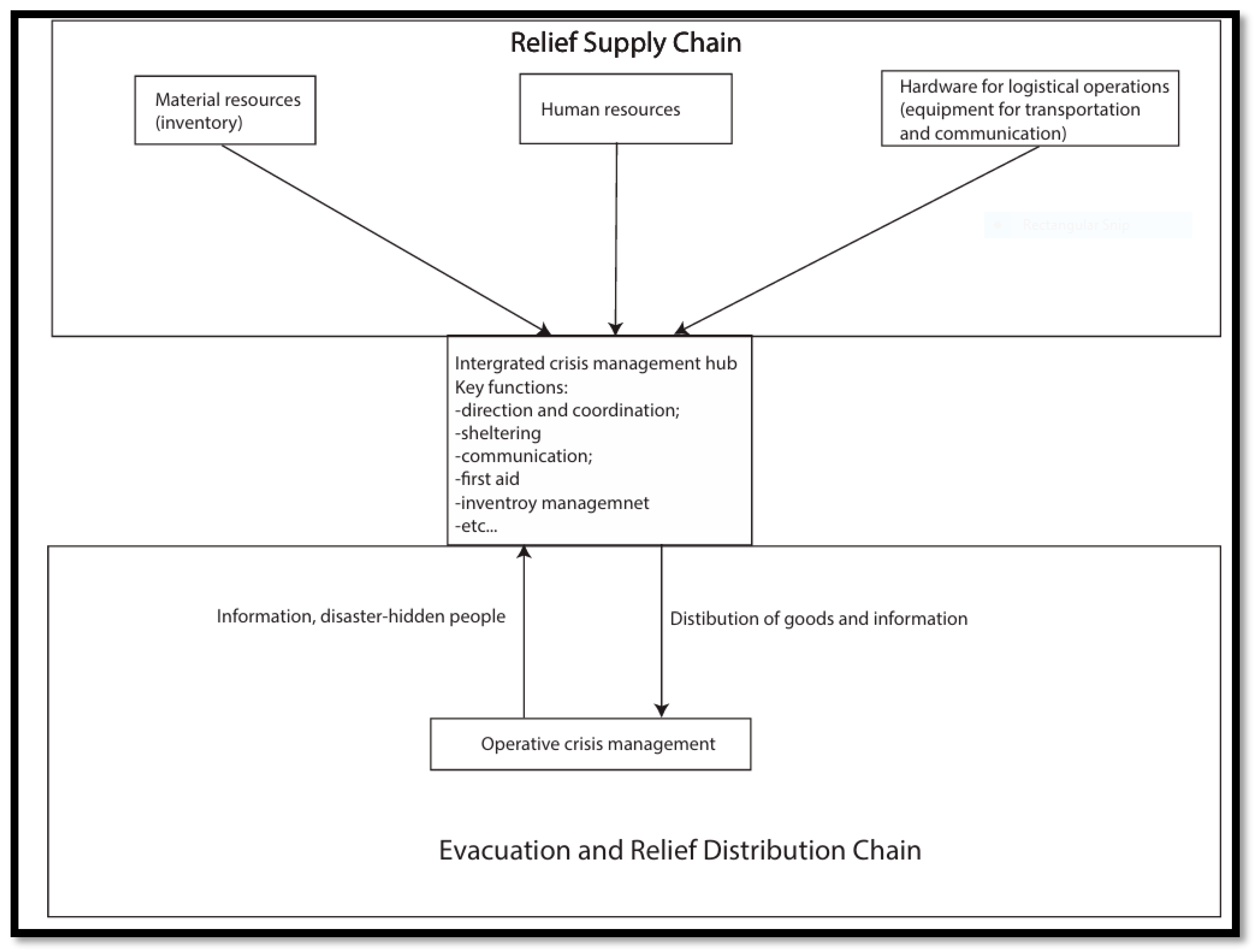
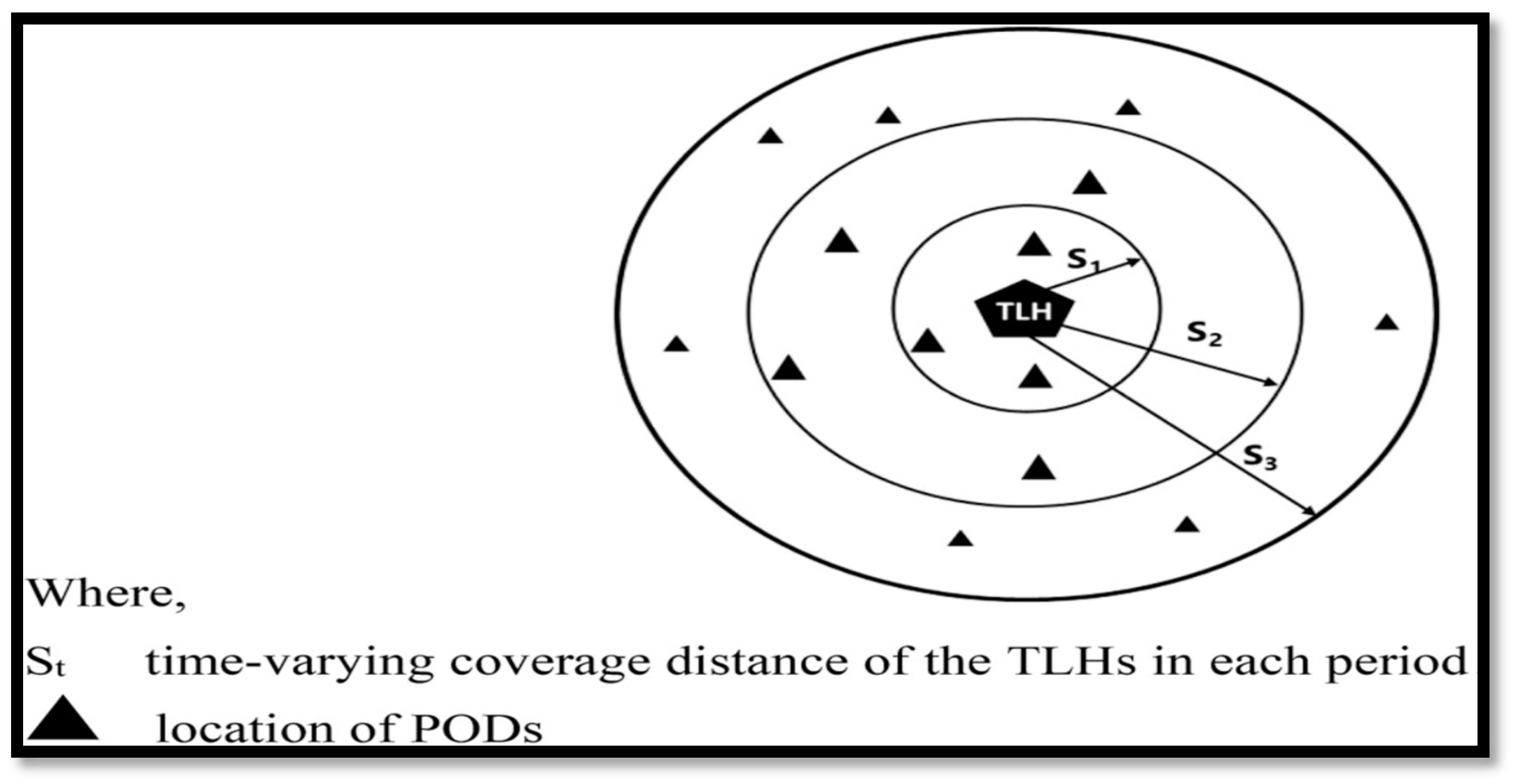
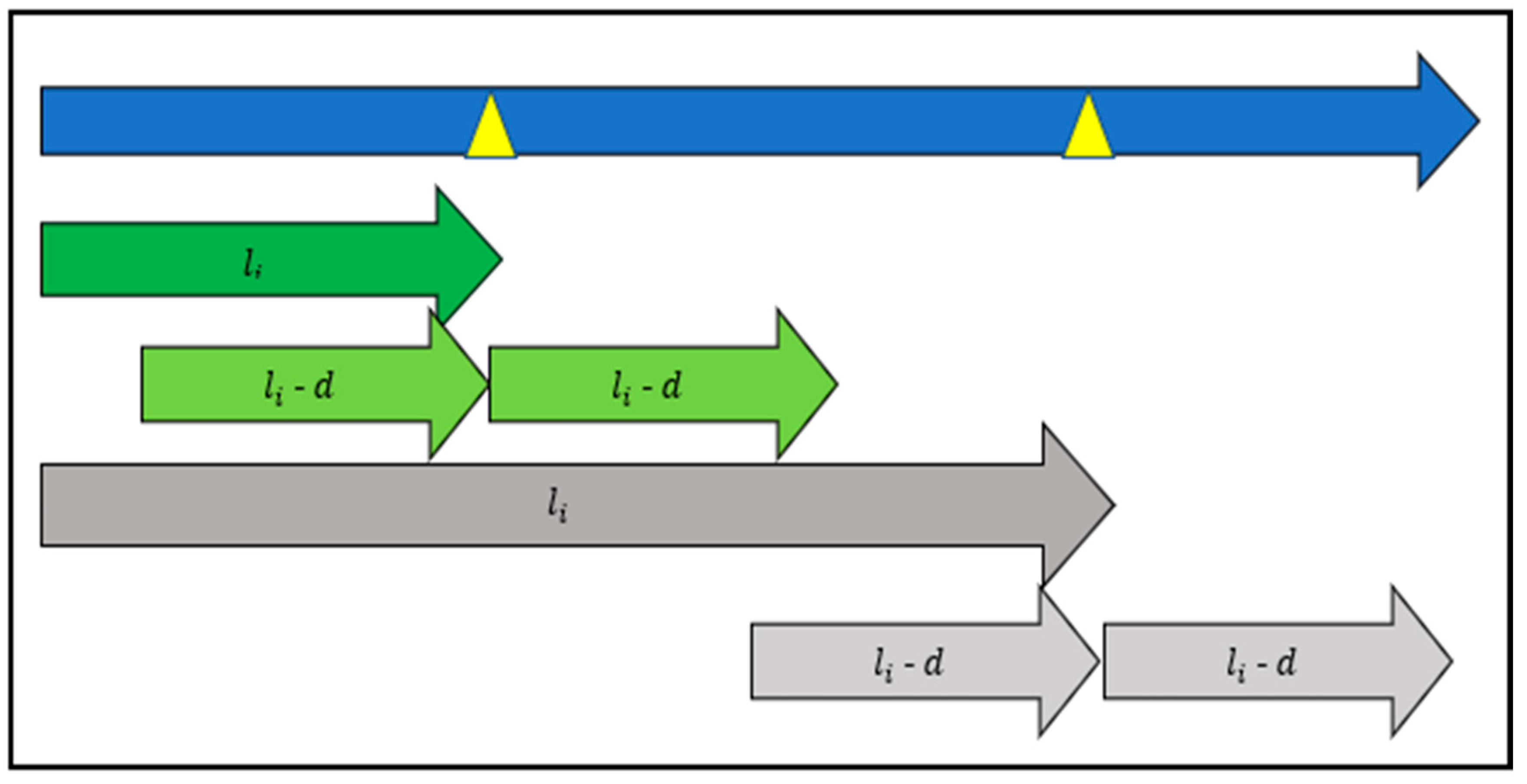

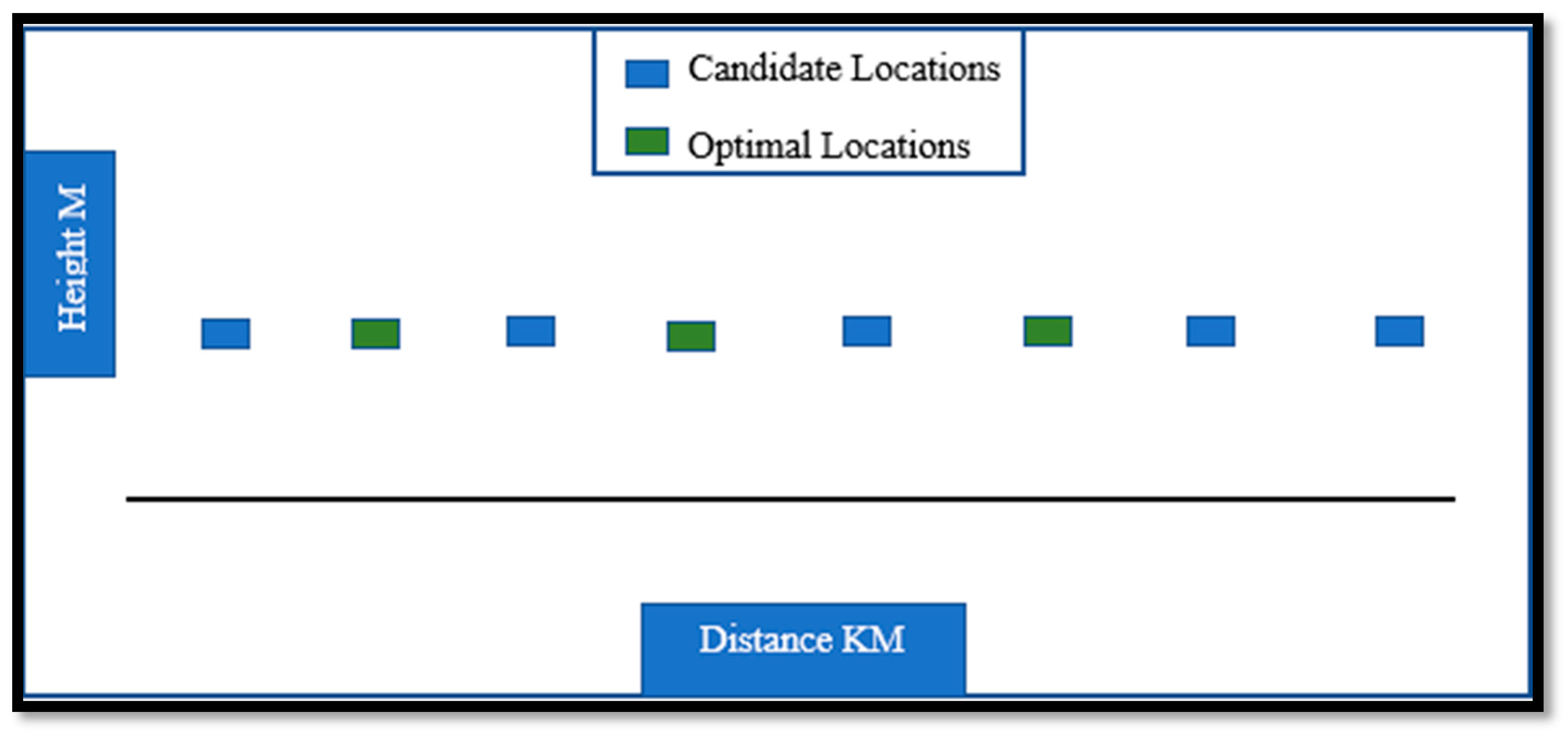
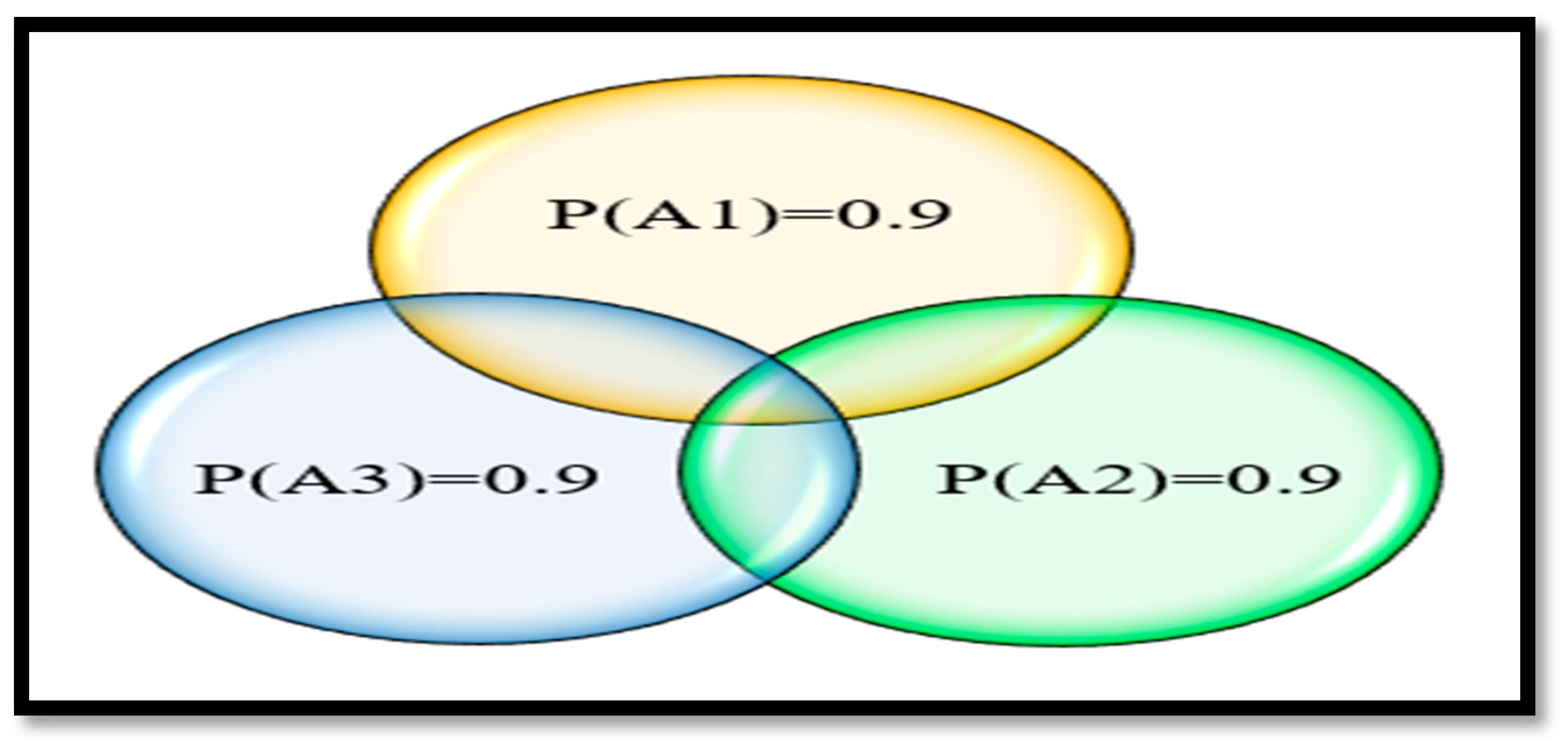
| Description | |
|---|---|
| The length of the segment to be defended. | |
| The number of potential locations selected is preliminary. | |
| The number of hubs to be selected in the final solution. | |
| The safety coverage distance, i.e., the closest hub to any place of the river may not be to a longer distance from the place than . | |
| The position of a potential location where is the distance from the initial point of the segment, and is the height of the location. |
| Notation | Description |
|---|---|
| The set of potential locations such that implies that . | |
| The set of potential locations such that they are right from i and their distance from i is not greater than 2d. | |
| A large positive number; see below how to choose it. |
| Notation | Description |
|---|---|
| The decision variable on the selection of potential location i. | |
| The objective function variable. |
| The Available Hubs to Locate | Distance (km) | Objective Function Value (M) | The Selected Locations to Locate the Hubs (Optimal Solution) |
|---|---|---|---|
| 12 | 20 | 13.69 | 3, 9, 12, 17, 18, 19, 20, 23, 27, 33,38, 44 |
| The Available Hubs to Locate | Distance (km) | Objective Function Value (M) |
|---|---|---|
| 12 | 20 | 13.69 |
| 15 | 20 | 13.69 |
| 25 | 20 | 13.14 |
| 12 | 25 | 14.63 |
| 15 | 25 | 14.25 |
| 20 | 25 | 13.69 |
| 25 | 25 | 13.14 |
| Events | A1 | A2 | A3 | A1A2 | A1A3 | A2A3 | A1A2A3 | M | Obj.F.Value | Optimal Solution |
|---|---|---|---|---|---|---|---|---|---|---|
| Probabilities | 0.90 | 0.90 | 0.90 | 0.89 | 0.8711 | 0.89 | 0.8701 | 0.95 | - | No feasible solution |
| 0.90 | 0.90 | 0.90 | 0.89 | 0.8711 | 0.89 | 0.8701 | 0.98 | - | No feasible solution | |
| 0.95 | 0.90 | 0.90 | 0.89 | 0.8711 | 0.89 | 0.8701 | 0.95 | 1 | X1 | |
| 0.95 | 0.90 | 0.90 | 0.89 | 0.8711 | 0.89 | 0.8701 | 0.80 | 1 | X1 | |
| 0.88 | 0.88 | 0.88 | 0.70 | 0.70 | 0.70 | 0.90 | 0.95 | 2 | X2, X3, Y23 | |
| 0.88 | 0.88 | 0.88 | 0.70 | 0.70 | 0.70 | 0.90 | 0.9 | 2 | X2, X3 | |
| 0.88 | 0.88 | 0.88 | 0.70 | 0.70 | 0.70 | 0.90 | 0.8 | 1 | X3 | |
| 0.88 | 0.88 | 0.88 | 0.70 | 0.70 | 0.70 | 0.90 | 0.7 | 1 | X3 |
Disclaimer/Publisher’s Note: The statements, opinions and data contained in all publications are solely those of the individual author(s) and contributor(s) and not of MDPI and/or the editor(s). MDPI and/or the editor(s) disclaim responsibility for any injury to people or property resulting from any ideas, methods, instructions or products referred to in the content. |
© 2025 by the authors. Licensee MDPI, Basel, Switzerland. This article is an open access article distributed under the terms and conditions of the Creative Commons Attribution (CC BY) license (https://creativecommons.org/licenses/by/4.0/).
Share and Cite
Al-Natoor, S.R.; Kovács, G.; Lakner, Z.; Vizvári, B. Determination of Temporary Hubs Locations Along a River in Case of Flood. Water 2025, 17, 1268. https://doi.org/10.3390/w17091268
Al-Natoor SR, Kovács G, Lakner Z, Vizvári B. Determination of Temporary Hubs Locations Along a River in Case of Flood. Water. 2025; 17(9):1268. https://doi.org/10.3390/w17091268
Chicago/Turabian StyleAl-Natoor, Suhad Rebhi, Gergely Kovács, Zoltán Lakner, and Béla Vizvári. 2025. "Determination of Temporary Hubs Locations Along a River in Case of Flood" Water 17, no. 9: 1268. https://doi.org/10.3390/w17091268
APA StyleAl-Natoor, S. R., Kovács, G., Lakner, Z., & Vizvári, B. (2025). Determination of Temporary Hubs Locations Along a River in Case of Flood. Water, 17(9), 1268. https://doi.org/10.3390/w17091268






